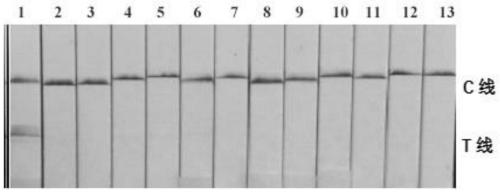Quick detection method and kit for chicken source component in food
A technology of chicken-derived components and detection reagents, applied in biochemical equipment and methods, microbiological determination/inspection, DNA/RNA fragments, etc., can solve the problems of inability to accurately quantify samples, high mitochondrial gene homology, and difficult detection and other problems, to achieve the effect of easy observation, good specificity and easy quantification
- Summary
- Abstract
- Description
- Claims
- Application Information
AI Technical Summary
Problems solved by technology
Method used
Image
Examples
Embodiment 1
[0039] Example 1 Screening of chicken source general internal standard gene LOC107053213
[0040] By searching the genetic information about chicken in GenBank, the target genome was downloaded from NCBI, and saved as ".FASTA" format. The whole genome information of the chicken was analyzed, and the homology analysis was carried out using BLAST and DNAMAN Version 4.0 software, and the LOC107053213 gene was screened out, which was located on the fourth chromosome. 20 kinds of meat (common domestic chicken (Gallus gallus), pheasant (Phasianus colchicus), turkey (Meleagris gallopavo), black-bone chicken (Gallus domesticus brisson), pig (Sus scrofa), beef (Bos taurus), sheep (Ovis aries), duck (Anas platyrhynchos), goose (Goose calicivirus), dog (Canis lupus familiaris), rabbit (Oryctolagus cuniculus), yak (Bos mutus), yellow croaker (Pseudosciaena polyactis), horse (Equus caballus), donkey (Equus asinus ), mouse (Mus musculus), buffalo (Bubalus bubalis), mink (Martes zibellina),...
Embodiment 2
[0041] Example 2 Establishment of LAMP Detection Method for Chicken Source Components
[0042] Utilize LAMP primer designingsoftware primerexplorer V 5.0 (http: / / primerexplorer.jp / elamp5.0.0 / index.html) LAMP primer online design software LAMP primer designingsoftware primerexplorer of Japan Rongyan Co., Ltd. to design LAMP primers for the LOC107053213 gene determined in Example 1, including 2 See Table 1 for outer primers F3 and B3 and 2 inner primers FIP and BIP. The 5' end of the inner primer FIP was labeled with biotin (Biotin), and the 5' end of BIP was labeled with fluorescein (FITC).
[0043] Table 1 LAMP primer sequence
[0044]
[0045] Using LAMP to quickly detect chicken samples, the reaction system is 25 μL, including 1× Thermopol buffer, 0.4mMdNTP, 3mM MgSO 4 , 1.0M betaine, 1.6 μM primer FIP, 1.6 μM primer BIP, 0.2 μM primer F3, 0.2 μM primer B3, 8U Bst DNA polymerase large fragment. The reaction program was constant temperature at 65°C for 1h and 5min at 85...
Embodiment 3
[0046] Example 3 Establishment of chicken source component LAMP product colloidal gold nucleic acid test strip detection method
[0047] Preparation of colloidal gold-labeled antibody The colloidal gold was prepared by the improved method of trisodium citrate, and the gold-labeled antibody was purified by high-speed centrifugation, and the prepared gold-labeled antibody was stored at 4°C for later use.
[0048] Dilute the FITC antibody with buffer to the optimal concentration respectively. The distance between the test line (TL) and the quality control line (CL) is 4.5 mm, and sprayed on the NC membrane at 1.0 μL / cm respectively. The sprayed NC membrane was dried overnight at 37°C for later use. Test strips were cut to a width of 3.8mm.
[0049] Fully mix the LAMP reaction product with the buffer solution and drop it on the sample pad of the colloidal gold nucleic acid test strip. At this time, the mixed solution passes through the binding pad and the NC membrane under the c...
PUM
 Login to View More
Login to View More Abstract
Description
Claims
Application Information
 Login to View More
Login to View More - R&D Engineer
- R&D Manager
- IP Professional
- Industry Leading Data Capabilities
- Powerful AI technology
- Patent DNA Extraction
Browse by: Latest US Patents, China's latest patents, Technical Efficacy Thesaurus, Application Domain, Technology Topic, Popular Technical Reports.
© 2024 PatSnap. All rights reserved.Legal|Privacy policy|Modern Slavery Act Transparency Statement|Sitemap|About US| Contact US: help@patsnap.com










